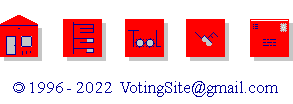|
Different uses for voting
need different types of voting. |
 |
Seats and Quotas |
 |

Quota NotesLER can incorporate any STV rules for quota and surplus transfers. It enables at least one new hybrid quota.It is surprising that some people get heated about which quota is “correct”. There are a half dozen in use and, except for the most bizarre, the choice makes little difference. The number of seats effects the accuracy of proportional representation more than the quota rule does. Recall that 5-seat PR districts create fewer “wasted votes” than 3-seat districts. That means fewer votes go to parties (or people) who fail to win a seat, and each party's share of seats is closer to its share of votes. Give the council enough seats so the quota is less than the voters in each significant faction. (Many organizations find it hard to find enough skilled candidates to fill a 5-seat council – not to mention hard to reward the council members for long hours of study and meetings.) |
| Table I. | Comparing PR Quotas | |||||
|---|---|---|---|---|---|---|
| Quota | Seats | |||||
| Rules | 3 | 5 | 7 | 9 | Formula | |
| Simple
Droop | 33.3
25 | 20
16.7 | 14.2
12.5 | 11.1
10 | =100/Seats
=100/(Seats+1) | -0.01
+0.01 |
|
A fraction of a vote must be added to the Droop quota to make sure the tally does not elect one too many (Seats+1) people. A fraction of a vote may be subtracted from the simple quota so the tally is sure to have enough ballots to elect [Seats] people despite any rounding errors.
A ballot with few preferences marked might have all of those candidates eliminated. The ballot may be treated as a tie for all remaining candidates, giving each of them a fraction of its weight; or the ballot and its weight may be ignored and the quota recalculated. A dynamic simple quota is Quota = (Weights Left / Seats Left) -0.01. |

A Brief History of Quotas
This page focuses on optional quotas for electing ensemble councils. Nicolaus Tideman and Daniel Richardson, wrote an excellent history of all STV quotes which is again available online Better Voting Methods Through Technology (retrived May 2015).
|
AB BA BR RB RS SR
|_____A______B________________R_______S____|
[ Even this is too simple for real life. Most groups do not have one-dimensional politics. The AR, AS, BS, RA, SA, and SB preferences occur. Concocted examples do not include the probabilities of such preferences and their effects. Simulations are needed for that next analytical step.]
Case 2 LERa fails, then switches to LERb or STVThe candidates were A, B, C, and R and 100 ballots were cast.Candidates A B C R
LERa with recommended quotas
|
| Table II: Share of votes needed to survive the last elimination | |||||||
|---|---|---|---|---|---|---|---|
| Seats | Rule | PR Seats | Quota | Min. | Max. | Chair | Notes |
| LERa
LERb STV Hare STV Droop | 3
2 3 3 | 37
50 33 25 | 20
26 17 25 | 32
34 25 25 | 25
0 NA NA | Note 1
Note 2 Note 3 Note 4 | |
| LERa
LERb STV Hare STV Droop | 5
4 5 5 | 21
25 20 17 | 11
13 11 17 | 19
21 17 17 | 17
0 NA NA | ||
|
Table II Notes:
The quotas above are rounded to the nearest whole number. Droop quotas round down; simple quotas round up. 1) LERa is listed with Droop quota for the chairperson and simple quota for the remaining seats. Chair quota = Ballots / (Seats+1) + 0.1 Rep quota = (Ballots - Chair quota) / Seats - 0.1 2) LERb has no quota for the chairperson. It is listed with the simple quota for reps. Notice that the maximum needed is about the same as Droop quota for 2 seats. 3) The minimum needed (Min) occurs when all but 1 seat has been filled. Take, for example, a 3 seat election under STV Hare with 2 seats filled. Slightly more than 66% of the ballots were used to elect those 2 winners, so just under 34% of the weight remains. A candidate with more than half of that (17%) will not be eliminated and will win. The maximum needed (Max) occurs when no one has won and the number of candidates remaining equals the number of seats plus 1. In the case of 3 seats under STV Hare, the last 4 candidates might have 25+, 25, 25, 25-. So 25% is needed to ensure a seat. 4) Notice that the Droop quota is the smallest number of votes that ensures the candidate is within the top [seats] candidates. Consider the case of a 5 seat council from an electorate with a 35% minority. With almost to two-fifths of the votes they should get 2 of the 5 seats. LERa recommends Droop quota (17%) for the chair and simple quota (21%) for the other seats. They have more than the 21% + 11% minimum needed for 2 seats but less than the maximum 2 × 19%.
Endnote: Some jurisdictions might not exemption the Condorcet winner from elimination but give her the advantage of a quota reduced by a gift of weight from all ballots. In that case the candidate with the lowest percentage of her quota is eliminated. If the first CW is eliminated, quota is reduced for the second winner. |
| |||||
|---|---|---|---|---|---|
| Electoral Systems | Legislative Systems | ||||
Chair
| Reps
|
Merits
More merits Condorcet + STV  Seats Shares | Policy
| Projects
| Budgets
|

|
|


 Accurate Democracy
Accurate Democracy 

